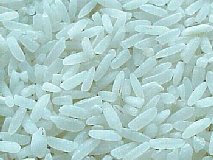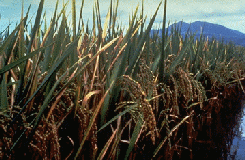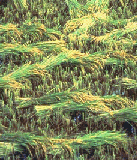Rice, White
http://www.100md.com
《e Natural Health Center》
 |
 |
 |
 |
Grains
Rice, White
Latin:
Oryza sativa
Origin:
The kernel of the seeds of the plant Oryza sativa L., belonging to the Gramineae family. This easily digested grain is the staple of half the world.
The origin of rice culture has been traced to India in about 3000 BC. Rice culture gradually spread westward and was introduced to southern Europe in medieval times.
, http://www.100md.com
The rice plant grows to about 1.2 m in height. The leaves are long and flattened, and its panicle, or inflorescence, is made up of spikelets bearing flowers that produce the fruit, or grain. It may be husked or unhusked.
With the exception of the type called upland rice, the plant is grown on submerged land in the coastal plains, tidal deltas, and river basins of tropical, semitropical, and temperate regions. The seeds are sown in prepared beds, and when the seedlings are 25 to 50 days old, they are transplanted to a field, or paddy, that has been enclosed by levees and submerged under 5 to 10 cm of water, remaining submerged during the growing season.
, 百拇医药
The harvested rice kernel, known as paddy, or rough, rice, is enclosed by the hull, or husk. Milling usually removes both the hull and bran layers of the kernel, and a coating of glucose and talc is sometimes applied to give the kernel a glossy finish. Thus called white rice, also known as polished rice.
In the 1960s, the so-called Green Revolution, an international scientific effort to diminish the threat of world hunger, produced improved strains of numerous food crops, including that known as miracle rice. Bred for disease resistance and increased productivity, this variety is characterized by a short, sturdy stalk that minimizes loss from drooping. Poor soil conditions and other factors, however, inhibited its anticipated widespread success.
, http://www.100md.com
The principal rice-producing countries are China, India, Japan, Bangladesh, Indonesia, Thailand, and Burma. Other important producers are Vietnam, Brazil, South Korea, the Philippines, and the United States.
In the late 20th century, the world rice crop averaged between 300,000,000,000 and 360,000,000,000 kg annually and was cultivated on an average of about 145,000,000 hectares.
Properties:
, 百拇医药
Sweet in flavor, mild (warm when produced in northern China) in nature, it is related to the spleen and stomach channels.
Functions:
Strengthens the spleen and stomach, clears the mind.
In traditional Chinese concept, it has long been claimed that rice strengthens the spleen-stomach and stops diarrhea. Thus, it is invigorating the middle-jiao and replenishing qi, strengthening the spleen and regulating the stomach, relieving thirst and restlessness, and arresting dysentery and diarrhea.
, 百拇医药
The porridge made of rice is believed to be the most powerful tonic of all. It is especially suitable for the aged, infirm, postpartum (after birth) women, and patients at the convalescent stage.
Sprouted rice is very helpful to digestion.
Roughly one-half of the world population, including virtually all of East and Southeast Asia, is wholly dependent upon rice as a staple food; 95 percent of the world's rice crop is eaten by humans.
, http://www.100md.com
Applications:
1. For chronic diarrhea with loss of appetite:
Immerse 250 g rice in cold water for a whole night. Then discard the water and bake to well done under slow fire and grind as powder. Add 5 g poria powder and mix thoroughly. Administer 30-40 g with sugar and pepper in small amounts.
2. For infirmity:
Prepare 60 g powdered rice to which cinnamon bark, prickly ash, Fructus Amomi, each 6 g, are added. All ingredients are mixed and pounded as powder. Drink 6 g with warmed boiled water, 3 times daily.
, http://www.100md.com
3. For indigestion:
Use 500 g rice crust (the brown hard portion around the wall and at the bottom of the pot), 100 g scorched hawthorn, 200 g Chinese yam, and 50 g Fructus Amomi. All ingredients are prepared as powder. Dosage is 10 g taken with some sugar, twice each day.
4. For diarrhea due to hypofunction of the spleen:
Prepare 100 g sweet rice, 30 g lotus seeds, 20 pieces Chinese red dates and 15 g poria. Clean all ingredients as usual and boil together with slow fire until rice is well done. Add suitable amount of sugar, and serve as regular meals.
, http://www.100md.com
Dosage and Administration:
Rice is cooked by boiling. It is eaten alone and in a great variety of soups, side dishes, and main dishes in Oriental, Middle Eastern, and many other cuisines.
Cautions on Use:
Patient with endogenous cold should eat less.
Reference Materials:
Toxic or Side Effects:
, http://www.100md.com
Modern Researches:
Rice that is processed to remove only the husks, called brown rice, is rich in starch (over 75 percent) and contains about 8 percent protein, 0.5 to 1 percent fats and is a source of thiamine, niacin, riboflavin, iron, calcium, arginine, paba, vitamins B, B1, F and H, glucose, surcrose and maltose.
Rice that is milled to remove the bran as well is called white rice and is greatly diminished in nutrients. When white rice forms a major portion of the diet, there is a risk of beriberi, a disease resulting from a deficiency of thiamine and minerals.
, http://www.100md.com
Parboiled white rice is processed before milling to retain most of the nutrients, and enriched rice has iron and B vitamins added to it.
The by-products of milling, including bran and rice polish (finely powdered bran and starch resulting from polishing), are used as livestock feed.
Oil is processed from the bran for both food and industrial uses.
Broken rice is used in brewing, distilling, and in the manufacture of starch and rice flour.
Hulls are used for fuel, packing material, industrial grinding, fertilizer manufacture, and in the manufacture of an industrial chemical called furfural.
The straw is used for feed, livestock bedding, roof thatching, mats, garments, packing material, and broomstraws., 百拇医药